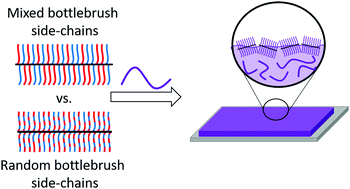Understanding interfacial segregation in polymer blend films with random and mixed side chain bottlebrush copolymer additives†
Abstract
Bottlebrush polymers are complex macromolecules with tunable physical properties dependent on the chemistry and architecture of both the side chains and the backbone. Prior work has demonstrated that bottlebrush polymer additives can be used to control the interfacial properties of blends with linear polymers but has not specifically addressed the effects of bottlebrush side chain microstructures. Here, using a combination of experiments and self-consistent field theory (SCFT) simulations, we investigated the effects of side chain microstructures by comparing the segregation of bottlebrush additives having random copolymer side chains with bottlebrush additives having a mixture of two different homopolymer side chain chemistries. Specifically, we synthesized bottlebrush polymers with either poly(styrene-ran-methyl methacrylate) side chains or with a mixture of polystyrene (PS) and poly(methyl methacrylate) (PMMA) side chains. The bottlebrush additives were matched in terms of PS and PMMA compositions, and they were blended with linear PS or PMMA chains that ranged in length from shorter to longer than the bottlebrush side chains. Experiments revealed similar behaviors of the two types of bottlebrushes, with a slight preference for mixed side-chain bottlebrushes at the film surface. SCFT simulations were qualitatively consistent with experimental observations, predicting only slight differences in the segregation of bottlebrush additives driven by side chain microstructures. Specifically, these slight differences were driven by the chemistries of the bottlebrush polymer joints and side chain end-groups, which were entropically repelled and attracted to interfaces, respectively. Using SCFT, we also demonstrated that the interfacial behaviors were dominated by entropic effects with high molecular weight linear polymers, leading to enrichment of bottlebrush near interfaces. Surprisingly, the SCFT simulations showed that the chemistry of the joints connecting the bottlebrush backbones and side chains played a more significant role compared with the side chain end groups in affecting differences in surface excess of bottlebrushes with random and mixed side chains. This work provides new insights into the effects of side chain microstructure on segregation of bottlebrush polymer additives.



 Please wait while we load your content...
Please wait while we load your content...
